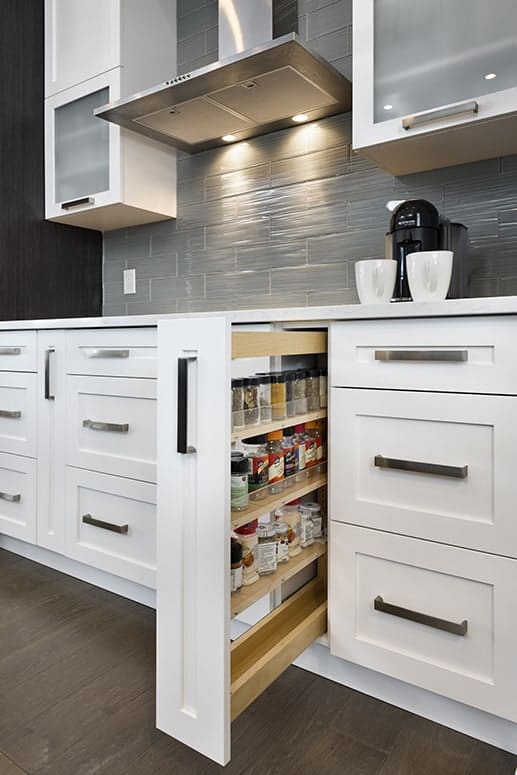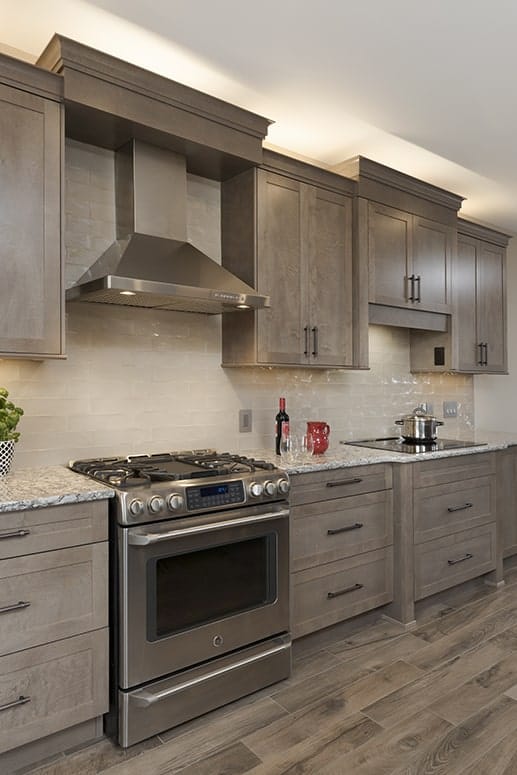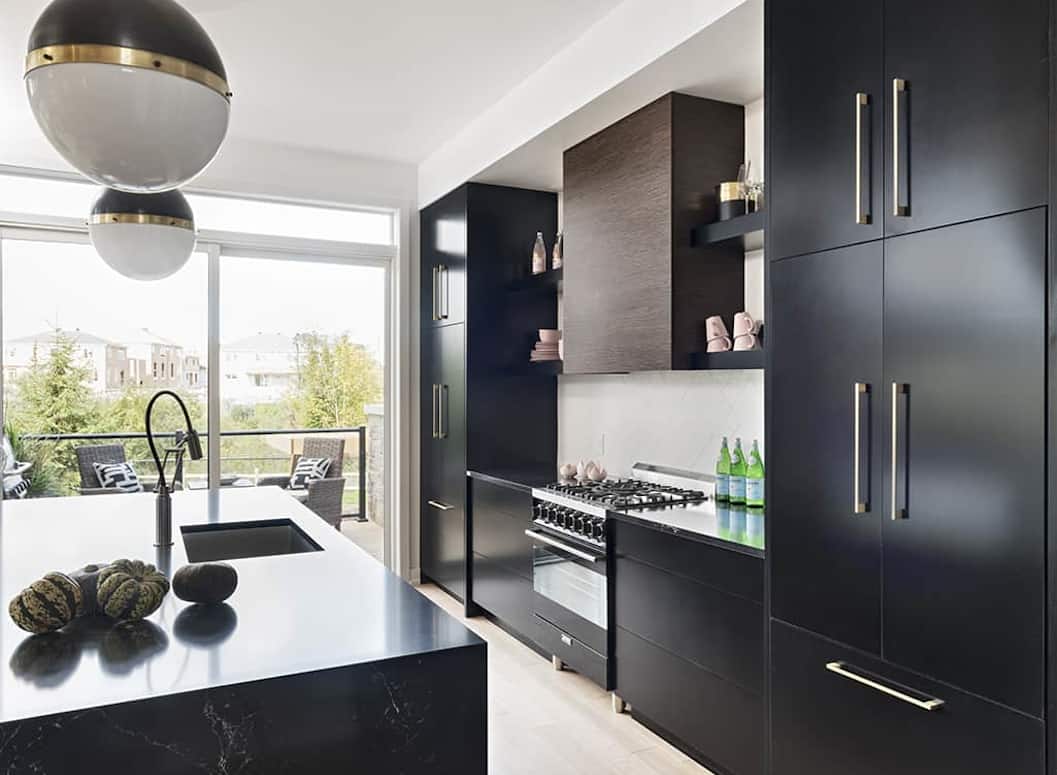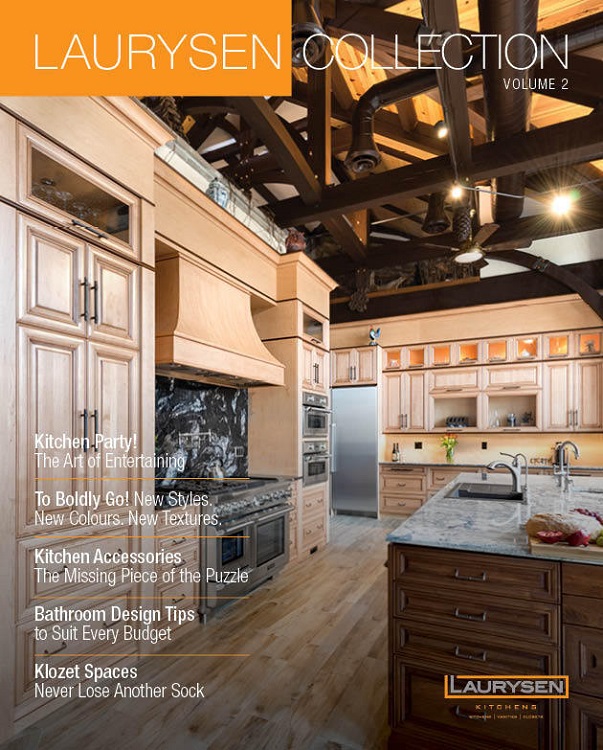If you’re new to a Ottawa kitchen remodeling project, you might be wondering about choosing custom or stock cabinetry. What’s the difference between custom vs prefab cabinets? What are “semi-custom” cabinets? How do you decide which is best for your home?
New kitchen cabinet shopping is fun and exciting, but it‘s often awfully confusing, too. In the prefab vs semi vs custom cabinetry debate, which one you choose will depend on a myriad of factors that only you can decide.
That’s where an experienced kitchen designer can play an essential role. The Laurysen award-winning kitchen design team explains the pros and cons of each cabinet type.
Looking For Ideas? Get Our Free Magazine.
What are Prefab Cabinets?
Prefab, short for prefabricated, cabinets are mass-produced and manufactured in standard sizes and designs. These cabinets are often available in stock at home improvement stores or cabinet showrooms.
Prefab cabinets are a cost-effective option for those who want a quick and budget-friendly solution for their cabinetry needs. They come in standard sizes, styles, and finishes, limiting customization options. However, they can be a convenient choice for basic kitchen or bathroom layouts.
What are Custom Cabinets?
Custom cabinets are built to order and offer the highest level of flexibility and personalization. Homeowners, designers, or contractors work closely with cabinetmakers to create cabinets tailored to specific dimensions, styles, materials, and finishes.
Custom cabinets are ideal for spaces with unique layouts, non-standard dimensions, or specific design preferences. While custom cabinets provide the most personalized solution, they also tend to be the most expensive option due to the craftsmanship and materials involved.
What are Semi-Custom Cabinets?
Semi-custom cabinets strike a middle ground between prefab and custom options. These cabinets are pre-manufactured like prefab cabinets but offer greater flexibility in terms of design and size.
While they come in standard sizes, homeowners can often choose from a range of modifications, such as adding certain features or changing the depth and height.
Semi-custom cabinets also offer a balance between affordability and customization, making them a popular choice for those who want more personalized options without the high cost associated with fully custom cabinets.
Prefab Cabinets (AKA Stock Cabinets)
PROS
Price: Prefab cabinetry usually comes with the lowest price tag.
Speed: They’re ready immediately (though if they’re delivered flat-packed from a big-box store, you still have to take time for assembly).
Easy to install: Big box stores have made it easy for most people (even those with little prior knowledge of construction or kitchen renovation processes) to build and install their prefab cabinets.
CONS
Poor value: You get what you pay for. Prefabricated cabinets are usually made of cheap materials, and their cost often does not include installation.
Flimsiness: “We find a lot of people regret installing prefab cabinets afterwards. For example, they’ve put all this money into a beautiful quartz countertop and then installed it onto prefab cabinetry. Often, the cabinetry base may not be as strong or as secure as they were hoping,” A member of our team explains.
Limited size range: Standard sizes may not suit your kitchen—or your needs.
Lack of kitchen design options: “With prefabricated cabinets, you’re working with what you’ve got rather than creatively working with your space,” comments our designer.
Won’t last long: Since stock cabinets are made to be as inexpensive as possible, the build quality is far less than what you’d find with quality custom cabinetry, and you may have to replace them sooner than you’d like.
Poor refinishing: While prefab cabinets offer convenience and affordability, the range of finishes is limited, and they tend to have a mass-produced quality. If you have specific colour or texture preferences, custom or semi-custom cabinets offer a broader selection of finishes to choose from.
Semi-Custom Cabinets

PROS
Price: Semi-custom cabinetry usually costs 15-30% less than fully custom cabinetry.
Perfect fit: These cabinets will fit into your kitchen without awkward gaps or exposed seams.
Design choices: A Laurysen designer enthuses, “With all the cabinet door styles and cabinet finish options, semi-custom cabinets really make the kitchen feel like your own.”
Colour: Pick from a wide range of colours for your cabinet doors. Why not mix and match light and dark cabinets or a contrasting wooden countertop for a unique, modern look?
Speed: Your semi-custom order will tend to arrive faster than custom cabinetry.
Easier to maintain: The flexibility in design and material choices that semi-custom cabinets offer allows homeowners to make decisions that prioritize functionality and ease of upkeep.
CONS
Size: Although you can customize certain features, you are still confined to standard cabinet dimensions, which may or may not work with your home remodeling project.
Custom Cabinets

PROS
Adaptability: It’s possible to design custom cabinets to work in any kitchen—even one with crooked walls and floors or other quirks.
Flexibility: Custom cabinets offer optimal use of space, personalized storage solutions, and the opportunity to change kitchen layout as you wish. In one of our designer’s words, “The sky’s the limit in what you can achieve in an open space.”
Traditional artisanship: Custom cabinet makers take care of every step of the process, from design through building and installation.
Luxurious details: You’ll be able to splurge on details such as quality wood, a “statement” kitchen island, and soft-closing doors and drawers.
Customize to your desire: Custom cabinetry allows for a completely personalized design. You can choose the exact dimensions, layout, material, and finishes to suit your specific needs, preferences, and the unique features of your space.
High durability: Custom cabinets are crafted with meticulous attention to detail and high-quality craftsmanship. A custom cabinet maker will use precision techniques and quality materials, resulting in sturdy and durable cabinets that can withstand daily wear and tear.
Easy refinishing: Custom cabinets are often seen as a long-term investment. Since they are built with durability in mind, they are more likely to withstand the test of time.
If custom cabinets do experience wear or style preferences change over the years, they can be refinished or repainted to give your kitchen space a fresh look without compromising structural integrity.
CONS
Cost: Custom cabinet prices are the highest of the three. They’re not cost-effective if you are listing your home within the next three years. This is due to the personalization you would place on the design and finishing materials.
Speed: Building custom kitchen cabinets is a lengthy process. Be prepared to work this extra time—plus potential delays—into your remodel schedule.
Why Choose Your Cabinets With The Guidance Of A Kitchen Designer?
Once again, one of our designers says it best: “It’s all about making the most out of your space and cabinetry. With set prefab sizes, you’ll potentially have a lot of room for filler, which is what a lot of people are trying to avoid.
“Going to a kitchen designer gives you more options. We’re very familiar with cabinetry; we live and breathe that stuff. At the end of the day, we’re giving you more innovative ideas for an ideal outcome.”
Looking for Kitchen Cabinet Ideas?
The right kitchen cabinet style, material and design will help you achieve the kitchen you’re dreaming of. Building custom cabinets might be outside your budget, but excellent cabinet makers like Laurysen offer semi-custom lines of kitchen cabinets that are still top-notch products and might be the perfect happy medium.
For beautiful, practical kitchen cabinet ideas, visit our showroom, browse our online galleries, request a copy of our magazine or speak with a designer.

